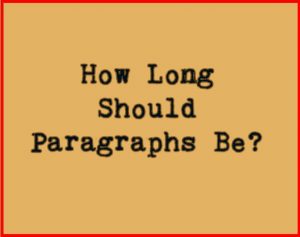How Long Should Paragraphs Be?
 When people are writing, they often wonder how long should their paragraphs be? Although there are no real set of numbers set when it comes to actual sentences in a paragraph, you should keep certain guidelines in mind.
When people are writing, they often wonder how long should their paragraphs be? Although there are no real set of numbers set when it comes to actual sentences in a paragraph, you should keep certain guidelines in mind.
The reality is that without properly writing your paragraphs or sentences correctly, your message can be lost or become muddle. The way you set up your sentences in each paragraph is what gives your writing direction.
For the most part, the average paragraph should be anywhere from three to seven sentences. Every paragraph you write is written as way to express or give the reader a central idea. The real basic requirements of a paragraph is the structure, as opposed to just the amount of words. But, there is also the type of writing you are doing to consider. There are some differences in how fiction and nonfiction paragraphs are written. Still, they both typically need to convey the information accurately.
Keep in mind that every paragraph has a basic structure which consists of three parts. They are an introduction, a body and the conclusion.
Don’t miss reading this guide on How To Use The Exclamation Point
The Big Three –
When you are writing a paragraph, the introduction needs to include a main topic sentence. It should also have whatever additional sentences are needed to give the reader background information. To support the topic, the body part of paragraph should include examples and/or facts. The final section or conclusion of your paragraph should generally bridge the continuing paragraph. And it should also mimic or support the concept you presented in your introductory paragraph.
The Single-Sentence Paragraphs
There have been numerous writers throughout history which have written single-sentence paragraphs. Some of them were very long and used to express a particular idea. You can find over 60 long sentences in literature demonstrating this example. Believe it or not, some of these include more than 100 word and go up as high as 2,000 plus words in a single paragraph.
The renowned American novelist, F. Scott Fitzgerald has been lauded for one of the longest and greatest, paragraphs in literature. The paragraph form The Great Gatsby goes on like this: “Its vanished trees, the trees that had made way for Gatsby’s house, had once pandered in whispers to the last and greatest of all human dreams; for a transitory enchanted moment man must have held his breath in the presence of this continent, compelled into an aesthetic contemplation he neither understood nor desired, face to face for the last time in history with something commensurate to his capacity for wonder.”
Not all writers use these single-sentence paragraphs though, only those that want to catch the reader’s attention. Or those that may want to tell or create a forceful moment in the story they are writing.
The Multiple-Sentences Paragraphs
The multiple-sentence paragraphs are very useful for those who want to keep their readers interested. Changing the lengths of your paragraphs will work to tell your main point. It can be as long as you needed to be in order to help you tell or explain your point. Using transition sentence in your paragraphs can help you stay consistent in your writing. It is also a good tip to use related grammatical structures. And you should repeat any words that are key to your main point. Transitional sentences work by taking the reader from one paragraph to the other seamlessly. A person can start a new paragraph and then begin working on the next topic sentence.
Here are Six Important Grammar Rules You Need To Know
In the end, the are no set rules for how long your paragraphs should be. Nor are there any for the amount of sentences it should have. Just remember that 3 to 7 are the norm. If the writing reads well, that is what will matter the most.
